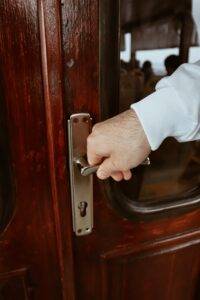 The quality of doors in England can vary based on several factors, and it’s not necessarily tied to a specific location but more so to the type of doors and the materials used. Here are some factors that can influence the quality of doors. The quality of doors depends heavily on the materials used in their construction. Solid wood doors, for example, are generally considered higher quality than hollow core doors. The craftsmanship and construction methods also play a role. Different manufacturers may produce doors of varying quality. Reputable brands often invest in quality materials and craftsmanship to build durable doors.
The quality of doors in England can vary based on several factors, and it’s not necessarily tied to a specific location but more so to the type of doors and the materials used. Here are some factors that can influence the quality of doors. The quality of doors depends heavily on the materials used in their construction. Solid wood doors, for example, are generally considered higher quality than hollow core doors. The craftsmanship and construction methods also play a role. Different manufacturers may produce doors of varying quality. Reputable brands often invest in quality materials and craftsmanship to build durable doors.
Exterior doors are typically built to higher standards to withstand the elements and provide security. Interior doors may vary in quality based on their intended use. The quality of the installation can impact the overall performance of a door. A well-installed door, with proper sealing and alignment, contributes to its longevity and effectiveness.
Doors in the UK are often subject to standards and regulations to ensure safety and performance. Compliance with these standards can influence the overall quality of doors. If you’re specifically interested in the quality of doors in a particular region, it might be beneficial to explore local suppliers and manufacturers. You could also consider looking into any regional variations in building codes or standards that may affect the quality of doors used in construction. As someone interested in security and construction, you might find it valuable to explore the materials and features that contribute to high-quality doors, especially those relevant to security and safety standards.
Credit: Clayton Carpentry
Humidity conditions can indeed have an impact on doors, and there can be regional variations in these effects. Different parts of the country in England may experience varying levels of humidity, which can influence the performance and longevity of doors. In areas with high humidity, wooden doors may be more prone to swelling and warping. Conversely, in drier regions, wooden doors may be more susceptible to drying out and shrinking. It’s essential to choose doors and finishes that are suitable for the local climate.
While metal doors are less prone to humidity-related issues like swelling or warping, they can be susceptible to corrosion in areas with high humidity or proximity to the coast. Regular maintenance and appropriate protective coatings can mitigate these issues.
Doors made from composite materials or engineered wood products are designed to resist the effects of humidity better than solid wood doors. These materials are often chosen for their durability and stability.
The effectiveness of door sealing and weather stripping is crucial in areas with varying humidity levels. Proper sealing helps prevent moisture from infiltrating and affecting the structure of the door. It’s advisable to consider the local climate and weather conditions when selecting doors for construction or renovation projects. Additionally, following recommended maintenance practices, such as periodic painting or sealing, can help protect doors from the adverse effects of humidity. Staying informed about regional climate patterns and their potential impact on building materials can contribute to making well-informed decisions. Certainly, there are several alternatives to traditional wood for external doors, each with its own set of advantages. When choosing a substitute for wood, consider factors such as durability, resistance to weathering, and overall aesthetic appeal.
Fiberglass Doors:
- Advantages: Fiberglass doors are durable, energy-efficient, and can mimic the look of wood. They are resistant to warping, and cracking, and are not as prone to moisture damage.
- Considerations: higher upfront cost compared to some other materials.
Steel Doors:- Advantages: Steel doors are known for their strength and security. They are resistant to warping, cracking, and pests. They can be coated to resist rust and corrosion.
- Considerations: Steel doors may not have the same aesthetic warmth as wood.

Credit: Front Door Online Ltd
Aluminium Doors:
- Advantages: Lightweight and resistant to corrosion, aluminium doors are suitable for coastal areas. They can be powder-coated for durability.
- Considerations: Aluminum may not provide the same insulation as other materials.
Composite Doors:- Advantages: Combining various materials like wood fibres and resin, composite doors offer the aesthetics of wood with enhanced durability and weather resistance.
- Considerations: Quality can vary depending on the specific composite materials used.
Vinyl or PVC Doors:
- Advantages: Vinyl doors are low-maintenance, resistant to moisture, and can be energy-efficient. They are also available in various styles.
- Considerations: Some people find the appearance less appealing compared to wood or other materials.
Engineered Wood Doors:- Advantages: Engineered wood products, such as plywood or MDF (Medium Density Fiberboard), can be used for doors. They offer more stability and resistance to warping than solid wood.
- Considerations: While more stable than solid wood, they may still be affected by extreme weather conditions.
When selecting a substitute, consider the specific requirements of your external doors, including climate, security needs, and design preferences. It’s often beneficial to consult with a door specialist or contractor to ensure the chosen material meets your expectations and performs well in your particular environment.
